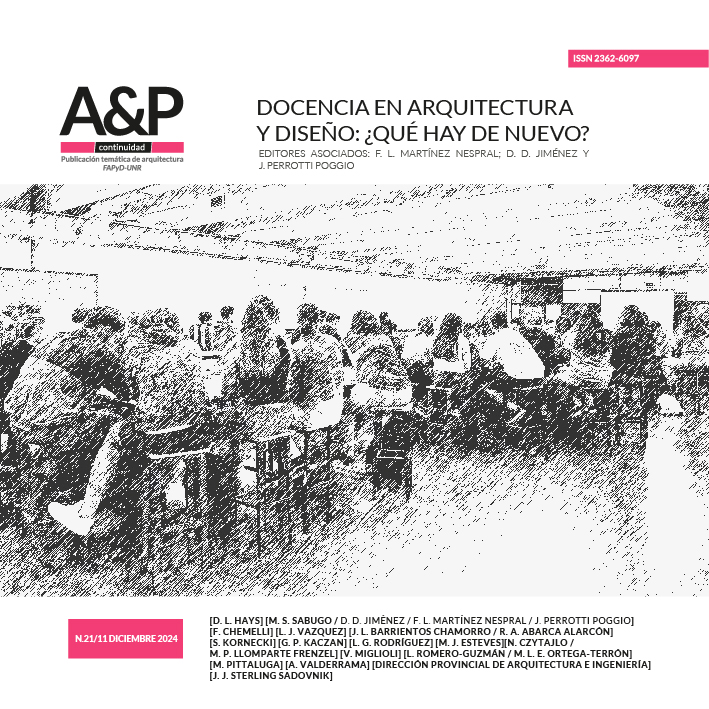Accompanying the return
An experience of group feedback in formative assessment
DOI:
https://doi.org/10.35305/23626097v11i21.495Keywords:
formative assessment, learning strategies, cognitive processAbstract
The years of the COVID 19 pandemic determined a before and an after for the educational field which led to the challenge of returning to face-to-face courses in 2022. That year, students who carried out distance learning for two years, in the isolation of their homes, without having previously attended the University, were received in the classrooms.
In the Architecture career, the workshop space and the group dynamics embody the basis for teaching all the subjects. Therefore, in this context, the return to face-to-face attendance implied a significant opportunity and a challenge for teachers and students.
Thinking about post-pandemic higher education requires great commitment from the teaching staff due to the need to adopt strategies devised to accompany students facing the new reality. In this sense, learning assessment as an instance of training is an opportunity for necessary monitoring and accompaniment.
This paper deals with the experience of self-assessment drift developed in the workshop of the History of Architecture course at UNDAV. It is considered a tool for accompanying students who return to the classroom which encourages practices that help them to learn how to use the new reality.
Downloads
Metrics
References
Anijovich, J. (2010). La Retroalimentación en la evaluación. En R. Anijovich (Ed.). La Evaluación Significativa (pp. 129-146). Buenos Aires, Argentina: Paidós.
Anijovich R., Cappelletti G. (2018). La Evaluación como Oportunidad. Buenos Aires, Argentina: Paidós.
Anijovich, R., Cappelletti G., Mora S. y Sabelli M. (2009). Transitar la Formación Pedagógica. Dispositivos y Estrategias. Buenos Aires, Argentina: Paidós.
Augustowsky, G. (2007). El registro fotográfico en la investigación educativa. En I. Sverdlick (comp.), La investigación educativa, una herramienta de conocimiento y de acción (pp.147-176). Buenos Aires, Argentina: Novedades Educativas.
Biggs, J. (2006). Calidad del aprendizaje universitario. Madrid, España: Narcea.
Gor Gómez, C. (2017). Deriva a través de la construcción del subconsciente colectivo: el territorio, la arquitectura, la ciudad, el libro. SOBRE, 3 (pp. 27-38). https://doi.org/10.30827/5555
Hoffman J. (2010). Evaluación Mediadora: una propuesta fundamentada. R. Anijovich (Comp.). La Evaluación Significativa (pp. 73-99). Buenos Aires, Argentina: Paidós.
Maggio, M. (2021). Educación en Pandemia. Buenos Aires Argentina: Paidós.
Maggio, M. (2022). Allá vamos: Nuevo capítulo de Híbrida. Buenos Aires, Argentina: Tilde Editora. Disponible en: https://digital.tilde-editora.com.ar/reader/alla-vamos-nuevo-capitulo-de-hibrida?
location=eyJjaGFwdGVySHJlZiI6ImJvb2tfMDAwMS54aHRtbCIsImNmaSI6Ii80LzIvMlt0b2NfNF0vMTowIn0=
Maggio, M. (2023) Híbrida: enseñar en la universidad que no vimos venir. Buenos Aires, Argentina: Tilde Editora.
Moretti, J. M. (Anfitrión) (2022). Híbrida junto a Mariana Maggio [Podcast]. Spotify. Disponible en: https://open.spotify.com/episode/3huHfLgBi3uT72iLp2UXY9?si=90e9d6f547574f9e
Perrenoud, P. (2007). La práctica reflexiva en el oficio de enseñar. Profesionalización y razón pedagógica. D.F., México: Colofón.
Perrenoud, P. (2008). La evaluación de los alumnos. De la producción de la excelencia a la regulación de los aprendizajes. Entre dos lógicas. Buenos Aires, Argentina: Colihue.
Sagol, C. (2013). Aulas aumentadas lo mejor de los dos mundos. https://www.educ.ar/sitios/educar/recursos/ver?id=116227
Scriben, M. (1967). The methodology of evaluation. En Tyler R., Gagne R. y Scriben M. (Ed.). Perspectives of curriculum evaluation (pp.39-83). Skokie, EE.UU.: Rand McNally.
Schön, D. (1992). La formación de profesionales reflexivos. Hacia un nuevo diseño de la enseñanza y el aprendizaje en las profesiones. Barcelona, España: Paidós.

Published
How to Cite
Issue
Section
License
Copyright (c) 2024 A&P Continuidad

This work is licensed under a Creative Commons Attribution-NonCommercial-ShareAlike 4.0 International License.
Open access policy
A&P Continuidad is a non-profit and open access publication. According to Mexico Declaration on Cultural Policies, the journal distribution is submitted to Creative Commons Attribution-Noncommercial-ShareAlike 4.0 International Public License (CC BY-NC-SA). “Neither the commercial use of the original work nor that of the possible derivative works are allowed. The distribution of derivative works should be submitted to the license regulating the original work. This license is not free.”
A&P Continuidad authorizes the partial or full reproduction of texts and graphs provided that the source is cited. Authors are exclusively responsible for the criteria expressed in the articles which do not necessarily reflect the opinion of the Editorial Committee or that of the Direction Board. The copyright of the published articles pertains to their authors or publishers.
Transfer of rights
The acceptance of an article to be published implies the author’s transfer of rights to the journal. Authors continue to have the right to use the material in future books or publications, approve or veto the republication of their works as well as the rights related to patents or other rights. Transfer of rights form may be downloaded here.























 This OJS site and its metadata are under a
This OJS site and its metadata are under a 

